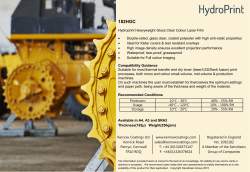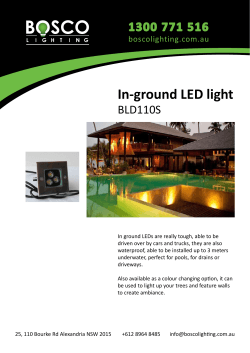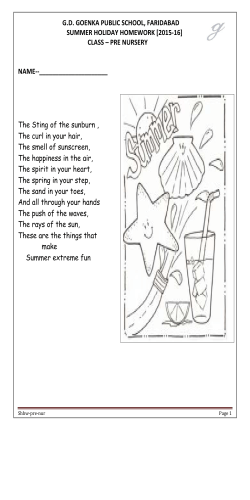
CHAPTER TWO REMOTE SENSING 2.1 Remote sensing:
CHAPTER TWO: REMOTE SENSING CHAPTER TWO REMOTE SENSING 2.1 Remote sensing: Remote sensing is a method of obtaining information about distant objects without direct contact. This is possible due to the generation of force fields between the sensing device and the sensed objects . Usable force fields are mechanical waves in solid matter (seismology) or in liquids (sound waves). However principal force field used in remote sensing is that of electromagnetic energy, as characterized by the Max well equation. The emission of electromagnetic waves is suitable for directional separation .Thus, images of the radiation incident on a sensor may be generated and analyzed . The remote sensing principle using waves of the electromagnetic spectrum. The energy radiates from an energy source may be a lamp, a laser or microwave transmitter with it is antenna. The radiation propagates through a vacuum with the speed of light, C, at about 300,000 KM/ second. It reaches objects, where it interacts with the matter of the objects. Part of the energy is reflected toward the sensor carried on a plat form, the intensity of the incoming radiation is quantized and stored. The stored energy values are transformed in to images, which may be subjected to image processing techniques before they are analyzed to obtain object information. See Figure (2.1). 3 CHAPTER TWO: REMOTE SENSING Figur (2.1) Principles of remote sensing 2.2 Electromagnetic radiation: 2.2.1 Basic law: Electromagnetic energy is radiated and body having a temperature higher than - 273°C or (O°K), the absolute zero temperature. Such a body radiates energy in all frequencies. The relation between frequency, V, and wave length, λ, is expressible as : λ =c/v (2.1) With λ expressed in and frequency in cycles / sec=hertz .The amount of radiation for a particular wave length over an interval, L11, is a function of the a solute temperature of the absolute temperature of the body in 0° and is expressed by planks' distributions low : L λ [T] is the spectral radiance in w 1m2. Sr. μm 4 CHAPTER TWO: REMOTE SENSING K = 1.38047.10-23[w.s.k-1], the Boltzmann constant . B = 6.6252.10-34 [J.S], the planks constant . C = 2.997925.10 cm8/s . This is based upon the observation that energy is emitted in energy quantum's. Q p', [J = W. S]. Wine's low permits us to determine the radiation maximum at a particular wavelength, λmax2 , depending on the body temperature by differentiating with respect to : λ max= ٠.٠٠٢٨٩٨ [ml] \ [k] (2.2) Since the surface temperature of the sun is about [6000ok], this means that the maximum radiance form solar energy will be generated at wavelength of [480 nm], which corresponds to green light. The earth, with its temperature between [273°k] and 300°k[0°C and 27°C] has its radiance maximum in the thermal range of the spectrum[8 μ m to 14 μ m] 2.2.2 Radiometric quantities: The dimensions of radiometric quantities used in absolute remote sensing are shown in table (2.1). 5 CHAPTER TWO: REMOTE SENSING Table (2.1) Radiometric quantities 2.3 Colour and colour photography: As human vision has the ability to distinguish different frequency components of the radiances of objects in the form of colour, a definition of the colour system has been necessary. The commission international l’Eclairage (CIE) has defined the three principal colours for the following wave length : Blue: 435.8nm Green: S46.1nm Red: 700.0nm Each perceived colour corresponds to an addition of the three principal colour components. All colours can be represented in the (CIE) chromaticity diagram shown in figure (2.2). 6 CHAPTER TWO: REMOTE SENSING Figure (2.2) Chromaticity diagram If the colours red, green and blue are equally represented, their mixing appears to the eye as white at particular intensity (brightness). On the outside curve of the diagram are pure colours corresponding to a particular frequency between (380 nm) and (770nm). These represented by the saturation (purity) of a colour . The colours may be generated artificially by the projection of images of different grey levels in the case for a computer or television screen, where there images filtered for the three primary colours are added . In the most photographic work, a colour subtractive process is used by absorption filters. This is based on the subtraction of a colour from white: White _ red = cyan . White _ green = magenta . White _ blue = yellow . In colour or false colour films, there separated film layers are used, witch have been sensitized and filtered for the three principal spectral ranges .A 7 CHAPTER TWO: REMOTE SENSING colour film has a blue sensitive layer followed by a yellow filter, than a green sensitive layer and finally a red sensitive layer attached to a film base . Let us now look at the exposure and development process .For colour reversal films producing a dispositive, the exposure with blue, green and red light will initiate the creation of metallic silver in the respective layers .The film is subjected to and white black and white development this develops the metallic silver in the respective layers. The result is a black and white negative, which is still light sensitive in the unexposed layers. A short subsequent illumination of the film will there for create silver in the previously unexposed layers. This silver is colour developed with colour dyes in complementary colours (cyan for red, magenta for green and yellow for blue). Bleaching of the film will convert all non colour coupled metallic silver salts .Thus a film will be the result, which in transparent viewing will yield the original object colours . Colour negative films possess the same three layers witch expose metallic silver in the respective layers. However; the generated silver in the directly developed with the colour dyes in the complementary colours, creating the oxidization product, which when copied by the same process can yield a colour image in the original colours . False colour photography utilized three layers sensitive to green, red and near infrared. The development process is similar to that of colour reversal film. The green sensitive layer appears blue in the infrared sensitive layer in red. The false colour film is particularly useful in interpreting the health of vegetation . 2.4 Digital imaging: The irradiated element of a digital imaging system is a photo diode. This charge - coupled device (CCD). 8 CHAPTER TWO: REMOTE SENSING The video signal can be captured using attuning signal up to thirty times per second by an analogue to digital convertor, called a (frame grabber). The frame grabber captures the exposure as a digital grey level. Value for later digital processing. The resolution of CCD sensors is limited by the sensor area and by the distance between the sensor elements. These determine a maximal sampling frequency. The geometrical properties of the sensor are governed by the precision with witch the sensor elements may be positioned in the image plane . 2.5 Radar imaging: The natural radiation in the microwave range of the electromagnetic spectrum is generally too weak to be use full for imaging. There for, passive sensing is rare. Radar imaging, there for, utilize a active sensor, generating the transmitted and reflected energy in the microwave region . Radar system has principally been built in three wave length : X Band, A = 2.4 cm to 3.8 cm [8000 to 12500 MHz] C Band, A = 3.8 cm to 7.5 cm [4000 to 8000 MHz] L Band, A = 15 cm to 30 cm [1000 to 2000 MHz] The X band and the C band in particular have the advantage of cloud penetration. They can therefore operate day and right in all weather system. 2.6 Satellites: After the launch of the first satellite sputnik by the former USSR in 1957, the first US satellites such as Trios 1 in 1960 began to carry remote sensing devices to image weather patterns . 9 CHAPTER TWO: REMOTE SENSING Most earth observation satellites (Land sat, spot, etc) prefer (imaging in the mode of a sun synchronous satellite. This is possible when a constant relation between orbital node and the direction to the sun .is mentioned . It also means scanning talking through satellites and planes with scientific studies and ground to provide information necessary to accomplish a large number of projects and mapping necessary and it also happened to the desert areas outside the agricultural area of the valley and delta in Egypt to determine the capabilities and potential of this land to set up a new communities outside the agricultural area. Aerial photos used in the planning of cities to choose which land suitable for housing. And land that is not suitable for trade or government offices. Also identifies trends city's natural areas and the selection of services such as water and sewage plants, airports and the power grid and airports as well as the site selection of reservoirs and dams and irrigation systems planning, sanitation and others. 2.7 Image interpretation: The image generated by a remote sensing sensor is subject to interpretation, before the remote. Sensing data can become information, while there is research looking at an automation process for the information, extraction procedure, and currently all practical interpretations are based on the human eye. Brain system at number. 2.7.1 Visual interpretation of images: Based upon the possibilities given by the human eye. Brain system, the interpretation of image by an analyst starts at a primary level observing contrasts of tone and color. At a secondary level, size, shape and texture are compared. At the third level, pattern, height difference and shadow aids in the 10 CHAPTER TWO: REMOTE SENSING interpretation. At a fourth level, the association with adjacent objects plays a role. 2.8 Multispectral classification: The objective of multi spectral classification is to analyze the spectral properties of unknown objects and compare them with spectral properties of known objects. Each spectral channel coincides with the grey level image matrices of other spectral channels. For each image a histogram of grey levels can be generated. A specific object class will produce a grey level distribution. Statistical parameters for this comparison are, for example: The mean of grey levels. The variance or the standard deviation. The maximum and minimum grey level for this object. Tow separable objects in this channel will produce tow grey level distributions. Tow channel define a tow. Dimensional feature space, in which the grey levels of different object types are shown as clusters see figure (3.4). Figure (2.3) Tow dimensional feature space with object clusters 11 CHAPTER TWO: REMOTE SENSING Classification can be performed in tow different ways: 2.8.1 Supervised classification: It's applied if a number of object types can be recognized in the images. This implies delineation of training are as a subset of image pixels and a generation of clusters for this area, determining their mean vector, this permits the direct use of the minimum distance classifier. Another simple possibility is to apply parallel piped classifier in which the parallel pipe dimensions are formed from the maximum and minimum grey values of the training areas for a certain object, with the risk of class overlaps. Most appropriate is the use of the maximum likelihood classifier for each object class with its covariance matrix. An internal check of the classifications accuracy is possible through analysis of classification for the training areas. There it is possible to generate a confusion matrix for all object classes, listing the total numbers of pixels in other object classes. Obviously, an overall check in this form should be made for data obtained in the field. 2.8.2 Un supervised classification: If no ground information to establish training areas is available, then clustering must be started by an iterative procedure estimating the likely location of clusters. For example, in three dimensional spaces, a set of clusters may be chosen along the diagonal at equal distances. Then a Preliminary minimum distance classification is made, and the mean vector of the cluster centers is formed. Then the process is iterated. The obtained clusters can again be checked via the divergence to decide whether some cluster. Should be merged. A maximum likelihood classification 12 CHAPTER TWO: REMOTE SENSING can follow the process. At the end the classification result can be assigned as a plausible object class. While the statistical approach to multispectral classification prevails in practice, another approach using neural net works is possible. The disadvantage of the pixel based multispectral classification approach is that homogeneous objects are not treated as a unit. This can be overcome by image segmentation. Image segmentation can be implemented either by edge detection techniques or by region growing. The classification algorisms may then be applied is the e-cognition “context based” classifier. If segment data are available through a (GIS) system, knowledge is introduced by a set of rules: If a condition exists, then inference is applied figure (3.5). Shows the example of a semantic network, which can be used to test segmented images for their content. Figure (2.4) Semantic network 13 CHAPTER TWO: REMOTE SENSING Source: illustration courtesy of institute for Photogrammetry and Geoinformation, University of Hannover. Examples for such rules are: If land sat band 7 > land sat band 5 then vegetation. If radar tone is dark, then smooth surface. It is also possible to incorporate texture parameters into the classification process. Characteristic texture parameters for an image region are: The autocorrelation function. Fourier transforms Grey level occurrence. 2.9 Fields of application: The interpretation of image has a great number of areas of application these include: Military intelligence , Environmental , Forestry , Agriculture , Topographic mapping , Coastal area survey , And archaeology , among others spectral, For some of these applications, interpretation keys with examples of imaged objects to be interpreted have been developed. Needs planned, which means setting style for the national and strategic planning to resolve problems that are related to the uses of the land are the two 14 CHAPTER TWO: REMOTE SENSING types of data : information on current land use, and information about the capabilities and potential of its natural resources . The satellite scans own natural resources, including out of available devices for imaging and sensing and passing above the earth several times each year, and send the data captured and analyzed by the computers, which is listed by the various uses of the land, The ones we get balance of enormous information at the regional level for large tracts in a single image can checking the distribution of tracts villages and cities scattered over an area of land over the entire province, and repeating the continuous monitoring of the same province for different time periods and compare the visuals from period to period we can follow changes in land use agricultural, and calculate the rates of urban expansion over this land. 15
© Copyright 2026









